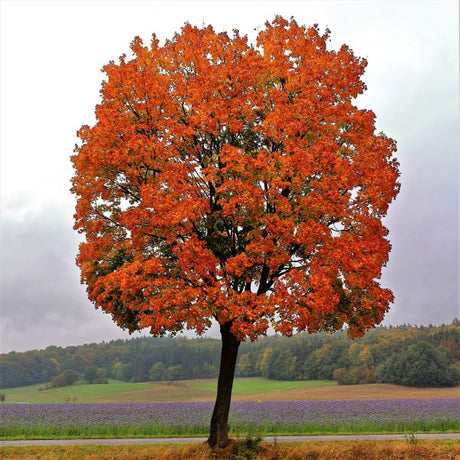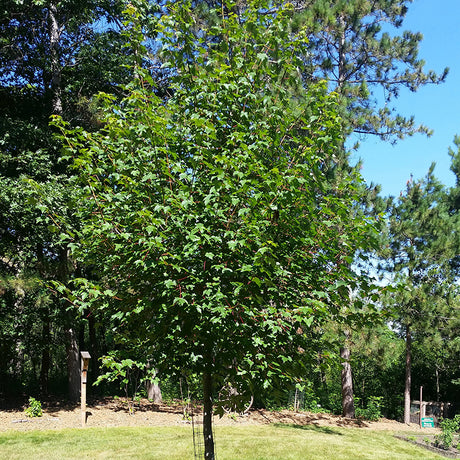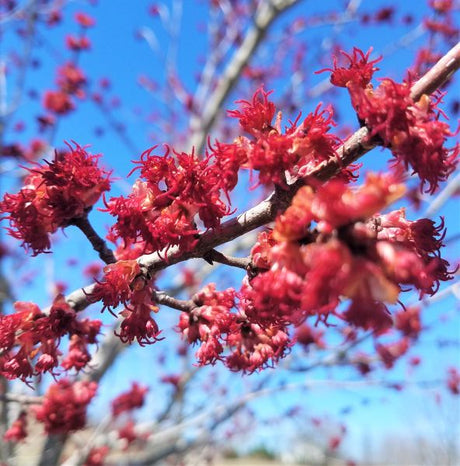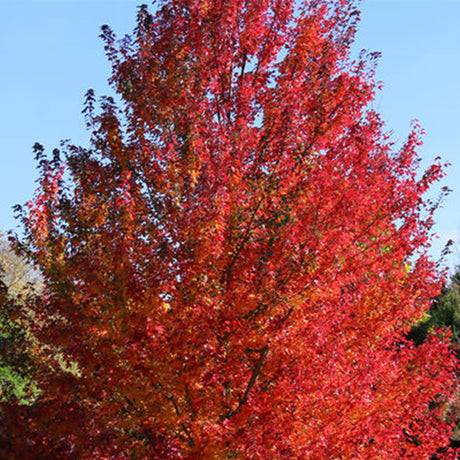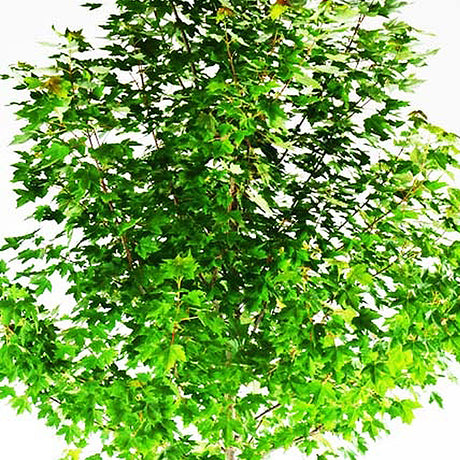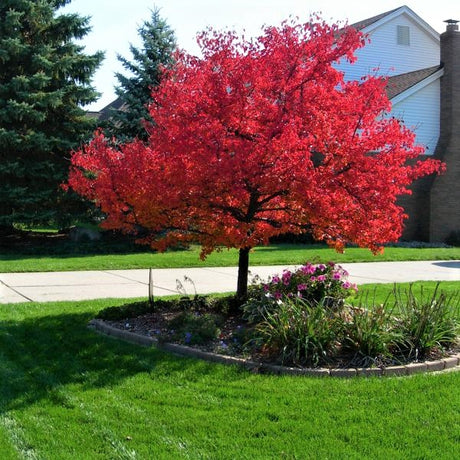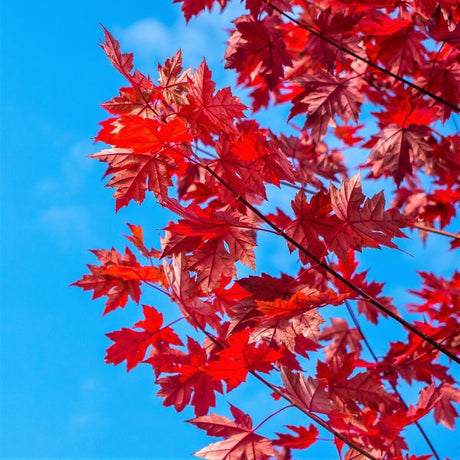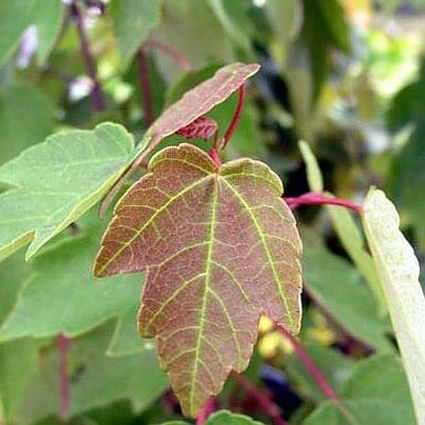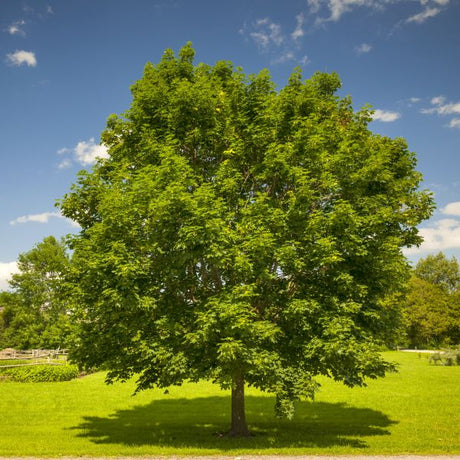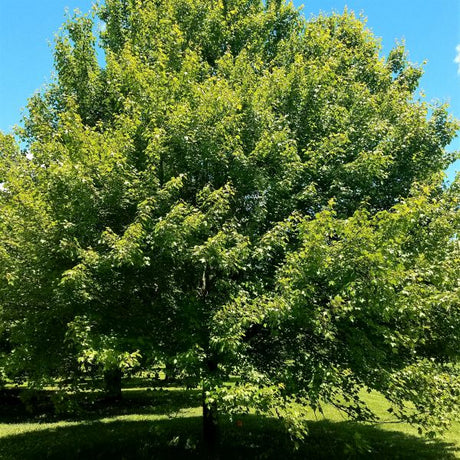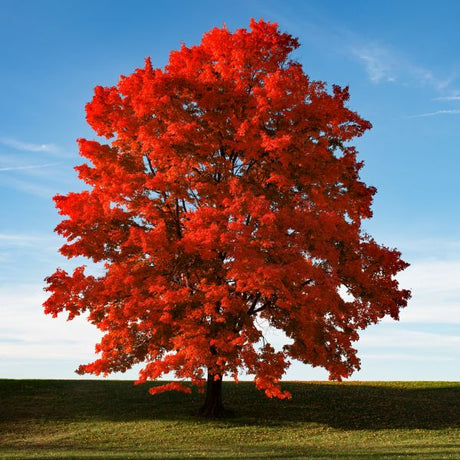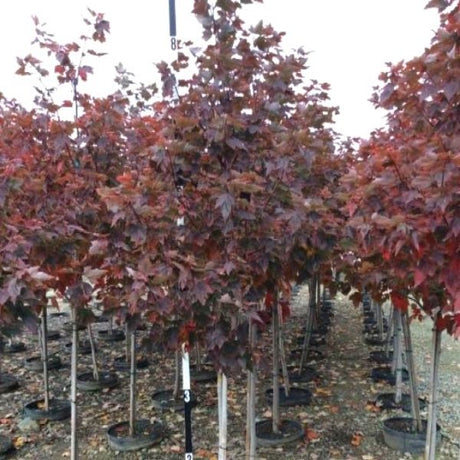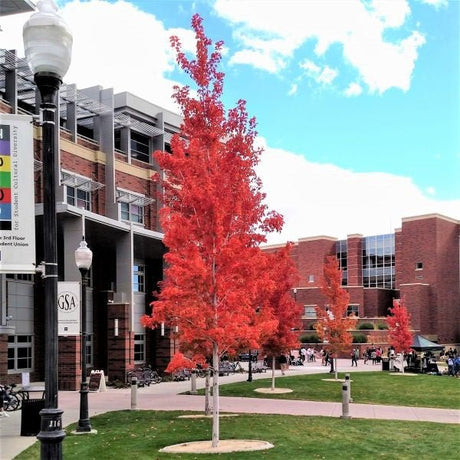Few trees capture the drama and beauty of the seasons quite like the Red Maple (Acer rubrum). From the first soft flush of crimson buds in spring to the blazing scarlet spectacle of fall color, Red Maples turn the landscape into a living watercolor.
Their rounded crowns, symmetrical branching, and elegant silhouettes dance with mother nature's moods, bright and warm in sunlight, shadowed and graceful in rain. These trees are among North America's most beloved natives, found from the swamps of the South to the rocky hillsides of New England, thriving almost anywhere they are planted.

With smooth gray bark maturing into a rugged, furrowed texture and three-lobed leaves that flutter in the gentlest breeze, Red Maples are the embodiment of both strength and softness.
They're fast-growing, adaptable, and breathtakingly colorful, the perfect marriage of beauty and resilience. As the days shorten, their chlorophyll fades, and hidden pigments emerge in radiant tones of red, gold, and orange ... nature's chemistry at work through photosynthesis.
- Landscaping Uses
- Care & Maintenance
- Top Red Maple Varieties at Nature Hills
- When the Forest Blushes Red
Landscaping Uses
Red Maples are true four-season showpieces. Their versatility allows them to shine as statement ornamental trees or shade trees in grand landscape designs. In spring, their scarlet blossoms feed pollinators and lend warmth to still-cool days. Followed by whimsical samaras that flutter in the wind.

Throughout the summer, their dense canopy offers a welcome refuge of shade, cooling patios, driveways, and lawns naturally. By fall, they ignite the horizon in vivid hues, while their upright or spreading form adds architectural beauty to any yard.
Top landscape uses:
-
Shade trees: Perfect for large yards, parks, and streetscapes.
-
Accent trees: Their vivid color provides focal points in mixed plantings.
-
Wildlife gardens: Nectar-rich flowers attract bees, while seeds feed songbirds.
-
Windbreaks and slopes: Upright varieties like Armstrong form colorful living walls that help reduce erosion.
- Reflection gardens: Their mirrored fall color on water features creates unforgettable scenes.
Pair Red Maples with flowering shrubs such as Hydrangea, Spirea, or Lilac for contrasting textures, or plant beneath with shade-loving perennials for shade like Hostas and Ferns. In fall gardens, combine them with Black-Eyed Susan, Russian Sage, or Ornamental Grasses for a painterly, multi-layered look, a simple way to extend color through the seasons.
For added wildlife appeal, surround your Maple with pollinator-friendly perennials and bird-friendly plants.
Care & Maintenance

Red Maples are remarkably adaptable but thrive best when given the right start. They prefer moist, slightly acidic soil and full sun to partial shade. Avoid extremely dry or compacted soils; though they can tolerate clay and occasional flooding, they don't fare well in prolonged drought. Healthy roots depend on soil health and well-drained soil.
Planting tips:
- Choose a site with at least 6 hours of sunlight per day. Make sure you have allowed for the mature width of these trees to give their large root systems plenty of space. Learn more about tree roots and infrastructure safety.
- Dig a wide planting hole, at least twice as broad as the root ball, and loosen the surrounding soil. Check proper planting depth.
- Water deeply and regularly for the first few years, especially during dry spells. Use the Finger Test to check when the soil needs moisture.
- Apply a mulch layer to maintain soil moisture and regulate temperature, but keep it a few inches away from the trunk and the tree's drip line.
- Avoid high-nitrogen fertilizers; use a slow-release, balanced formula once in early spring. For guidance, see tree planting best practices.
Maintenance essentials:
-
Pruning: Best done in late winter or early spring before new growth begins. Remove crossing or dead branches to maintain a strong structure.
-
Watering tips: Once established, Red Maples are moderately drought-tolerant but perform best with consistent moisture.
- Protection: Use tree guards on young trunks to prevent bark damage from sunscald or animals.
Top Red Maple Varieties at Nature Hills

Each Red Maple variety brings its own twist on fiery foliage and graceful form.
-
Red Maple Tree (native variety): The classic native, known for its brilliant scarlet fall color and wide adaptability.
-
Summer Red Maple Tree: Features maroon-red new growth that stays tinted through summer for extended color.
-
Redpointe® Red Maple Tree: A refined, upright form with exceptional symmetry and stunning red-orange autumn color.
-
October Glory® Red Maple Tree: Famous for its long-lasting, late fall display of bright crimson-red leaves.
-
Red Sunset® Maple Tree: One of the earliest to turn color - vibrant orange-red foliage that glows before frost.
-
Summer Sensation® Red Maple Tree: Noted for its strong central leader, yellow fall color, and tolerance of variable soils.
-
Autumn Fantasy™ Red Maple Tree: A hybrid marvel that combines rapid growth with intense red foliage and cold-hardiness.
- Armstrong Red Maple Tree: Compact, narrow habit perfect for small yards or framing walkways, this is a Silver Maple and Red Maple hybrid.
Each of these selections offers brilliant fall color, reliable growth, and easy-care performance, making them some of the most requested pollution-tolerant trees at Nature Hills.
When the Forest Blushes Red
When autumn winds whisper and the sunlight takes on that golden edge, few sights rival a Red Maple in full color. Its canopy blazes against a cool sky, lighting up driveways and lakesides with a warmth that seems to come from within. This tree doesn't just mark the passage of the seasons ... it celebrates them!
A Red Maple's beauty lies not only in its color but in its message: growth, change, and renewal are all part of the same grand cycle!
Plant one, and each year you'll watch the world's most beautiful reminder unfold right in your own yard.
Happy Planting!
Find your USDA Growing Zone before planting to ensure your Red Maple thrives in your climate.


